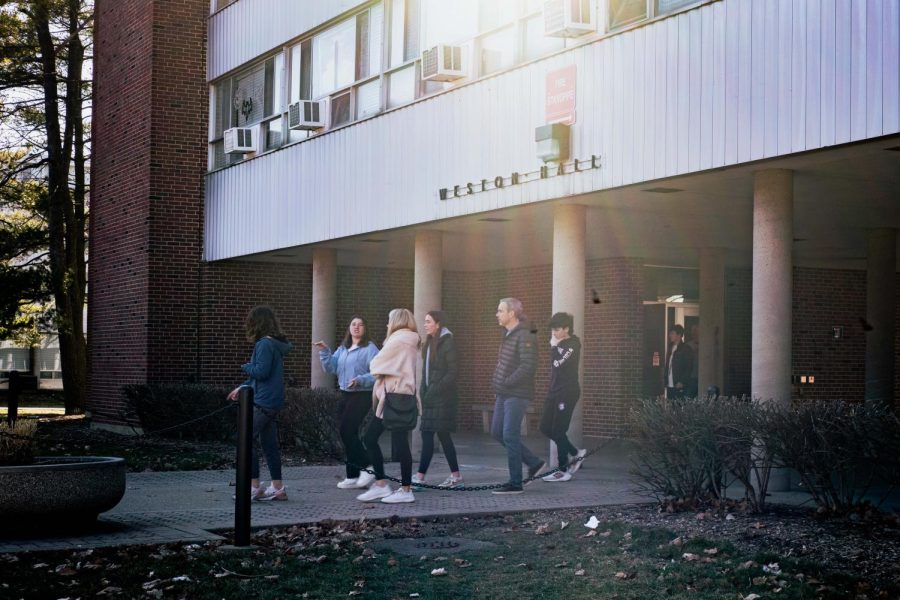Opinion | On-campus living deserves a revamp
Students, friends and family walk out of Weston Hall during a sunny Sunday afternoon. Columnist Megan Harding writes on the benefits that makes university housing the top choice to live in on campus.
February 20, 2023
Living in a dorm during freshman year is a character-building experience, as it forces students to learn to live with another person in close quarters, problem solve and make new friends. Residence hall life is an important stepping stone between living with your parents and being completely independent.
On-campus living also reminds students not to take anything for granted: personal space, cleanliness or long, hot showers.
Even with these inconveniences in mind, living on campus gives students stability and protection they are not as likely to get living off campus: enforced security measures, financial aid packages that determine the cost and, most importantly, the meal plans that come with on-campus housing make students less likely to be food insecure.
However, there are some pleasantries the University could add that would take dorming to the next level.
1. Bathroom modernization
Get The Daily Illini in your inbox!
For the $10,000 or more students pay to live in the dorms per year, a bathroom should at least be free of 70s-inspired, blue-and-pink tile and a complete lack of privacy.
Stalls could be designed to be fully enclosed without gaps at the top or bottom. This way, when students are using the bathroom, they have more privacy and do not feel as surrounded.
Nugent, Wassaja, PAR and ISR have already taken the steps to create more private spaces. They have individual-use bathrooms that allow residents to take a shower and use the bathroom without someone sitting right next to them.
This is not suite style since there are far more rooms than bathrooms, but it does allow students to have much-needed alone time they do not get anywhere else.
The interior design and aesthetics of bathrooms could also be improved. The design elements and good lighting in bathrooms such as CIF and Siebel Center for Design could be implemented in dorm bathrooms to create a more clean finish.
2. Air conditioning improvements
While most dorms are equipped with window air conditioning units, they are only on for August, September and some of October. Not only is there a possibility of hot days in late October and early November, but having heaters on in the winter makes rooms both humid and musty. For the extra cost residents must pay to live in an air-conditioned room, it should be more accessible.
Additionally, the units could be cleaned or replaced more regularly to prevent mold from growing on the inside, which happens when dust continues collecting.
Most dorms on campus offer air conditioning, but Allen, LAR, Taft-Van Doren, Barton and Lundgren all come without air conditioning. Even with a fan, Illinois summers can make rooms hot, sticky and unbearable. Having air-conditioned rooms for every dorm would make living on campus even more appealing.
3. Lounge decor
Many dorm lounges feature cement walls, fluorescent lighting, hard plastic tables and chairs, and a few blue and green couches that have most likely not been replaced in the last decade.
Since most dorm rooms barely have enough room to fit both a desk and a bed on either side, using the room as a study environment is not always productive.
Without stripping the entire lounge, a few purchases from Amazon or even a local thrift store could give the lounge areas a much-needed makeover.
To start, the walls could be made less bare with hanging plants, photographs or artwork. Each table could have a lamp, or there could be strings of cool-colored lights around the area.
The room could be complete with a beanbag and faux fur desk chairs that could double as a relaxing place to sit or a chair that will not hurt after sitting and doing homework for hours.
4. Food quality
As mentioned above, the meal plans available through University Housing are an easy option for students to eat without worrying about spending money at the grocery store and cooking their own meals with an already busy schedule.
However, some of the meals are unhealthy and lack variety. The smell of grease lingers on clothing after leaving the dining hall, a sign that the food may not be prepared in the healthiest ways. There are also weeks where the same foods are being served every single day, which does not allow for much variety.
While there is an effort to include vegetarian and vegan options with the salad bar and meatless burger alternatives, meat-free entrees are not available all of the time, and eating a salad for every meal is not ideal.
The University has so much potential to make the most of the living spaces they offer for students. On-campus living isn’t necessarily a bad option, but more could be done to make continuing residence hall life after freshman year more enticing.
With the argument that living in an off-campus apartment is the better option, the University has the choice to facilitate an environment that surpasses the off-campus benefits and makes students feel at home.
Megan is a freshman in Media.










